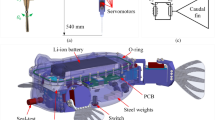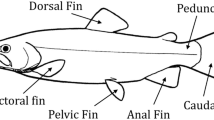Abstract
Undulation fishes, whose propulsion is mainly achieved by undulating ribbon fins, are good at maneuvering or stabilizing at low speeds. This paper suggests and proposes a two-dimensional approximate computational model, which is used to conduct an initial analysis on undulation propulsion scheme. It is believed that this undulating mode has a better potential for exploitation in artificial underwater systems. Hydrodynamics of two-dimensional undulating fins under a series of kinematical parameter sets is explored via numerical simulation. The periodicity of undulation forces and moments is studied. The effects of inlet velocity, wavelength, undulation frequency, and undulation amplitude are investigated. Furthermore, a dimensionless two-parameter model for undulation surge force is established with a given wavelength (in terms of, a single wavelength or a dual wavelength) using statistical method. The work in this paper is able to provide studies on bionic undulation mode. It has also formed a meaningful basis for three-dimensional (3D) hydrodynamics and corresponding control methods in bionic undulation robots.
Similar content being viewed by others
References
Sfakiotakis M, Lane D M, Davies J B C. Review of fish swimming modes for aquatic locomotion. IEEE Journal of Oceanic Engineering, 1999, 24, 237–252.
Hu T J, Shen L C, Lin L X, Xu H B. Biological inspirations, kinematics modeling, mechanism design and experiments on an undulating robotic fin inspired by Gymnarchus niloticus. Mechanism and Machine Theory, 2009, 44, 633–645.
Blake R W. Fish functional design and swimming performance. Journal of Fish Biology, 2004, 65, 1193–1222.
Kato N. Median and paired fin controllers for biomimetic marine vehicles. Applied Mechanics Reviews, 2005, 58, 238–252.
Lighthill M J, Blake R W. Biofluiddynamics of balistiform and gymnotiform locomotion. Part 1. Biological background and analysis by elongated-body theory. Journal of Fluid Mechanics, 1990, 212, 183–207.
Lighthill M J. Biofluiddynamics of balistiform and gymnotiform locomotion. Part 2. The pressure distribution arising in two-dimensional irrotational flow from a general symmetrical motion of a flexible flat plate normal to itself. Journal of Fluid Mechanics, 1990, 213, 1–10.
Lighthill M J. Biofluiddynamics of balistiform and gymnotiform locomotion. Part 3. Momentum enhancement in the presence of a body of elliptic cross-section. Journal of Fluid Mechanics, 1990, 213, 11–20.
Lighthill M J. Biofluiddynamics of balistiform and gymnotiform locomotion. Part 4. Short-wavelength limitations on momentum enhancement. Journal of Fluid Mechanics, 1990, 213, 21–28.
Shirgaonkar A A, Curet O M, Patankar N A, Maclver M A. The hydrodynamics of ribbon-fin propulsion during impulsive motion. Journal of Experimental Biology, 2008, 211, 3490–3503.
MacIver M A, Fontaine E, Burdick J W. Designing future underwater vehicles: Principles and mechanisms of the weakly electric fish. IEEE Journal of Oceanic Engineering, 2004, 39, 651–659.
Sfakiotakis M, Lane D M, Davies B C. An experimental undulating-fin device using the parallel bellows actuator. IEEE International Conference on Robotics and Automation, Seoul, Korea, 2001, 2356–2362.
Bozhurttas M, Tangorra J, Lauder G, Mittal R. Understanding the hydrodynamics of swimming: From fish fins to flexible propulsors for autonomous underwater vehicles. Advances in Science and Technology, 2008, 58, 192–202.
Toda Y, Ikedab H, Sogihara N. The motion of a fish-like under-water vehicle with two undulating side fins. The Third International Symposium on Aero Aqua Bio-mechanisms (ISABMEC 2006), Ginowan, Okinawa, Japan, 2006.
Willy A, Low K H. Development and initial experiment of modular undulating fin for untethered biorobotic AUVs. The IEEE International Conference on Robotics and Biomimetics. Hong Kong, China, 2005, 45–50.
Hu T J, Shen L C, Low K H. Bionic asymmetry: From amiiform fish to undulating robotic fins. Chinese Science Bulletin, 2009, 54, 562–568.
Low K H, Zhou C L, Seet G L, Yu J Z. Learning from Gymnotiform swimmers — Design and implementation of robotic knifefish NkF-II. International Journal of Information Acquisition. 2008, 5, 127–135.
Toda Y, Danno M, Sasajama K, Miki H. Model experiments on the squid-like underwater vehicle with two undulating side fins. The 4th International Symposium on Aero Aqua Bio-mechanisms (ISABMEC 2009). Shanghai, China, 2009.
Zhou H, Zhang D B, Hu T J, Xie H B, Shen L C. Statistical hydrodynamics modeling of two-dimensional undulating fins for robotic fish. IEEE International Conference on Robotics and Biomimetics, Guilin, China, 2009, 1663–1668.
Liu H, Kawachi K. A numerical study of undulatory swimming. Journal of Computational Physics, 1999, 155, 223–247.
Kowalczyk W, Delgado A. Simulation of fluid flow in a channel induced by three types of fin-like motion. Journal of Bionic Engineering, 2007, 4, 165–176.
Sitorus P E, Nazaruddin Y Y, Leksono E, Budiyono A. Design and implementation of paired pectoral fins locomotion of Labriform fish applied to a fish robot. Journal of Bionic Engineering, 2009, 6, 37–45.
Adkins D, Yan Y Y. CFD simulation of fish-like body moving in viscous liquid. Journal of Bionic Engineering, 2006, 3, 147–153.
Hu T J. Undulation Adaptability Theory and Control for the Biomimetic Undulating Fins. Doctor Dissertation, National University of Defense Technology, Changsha, China, 2009. (in Chinese)
Zhang Y H, Jia L B, Zhang S W, Yang J, Low K. H. Computational research on modular undulating fin for biorobotic underwater propulsor. Journal of Bionic Engineering, 2007, 4, 25–32.
Hu T J, Li F, Wang G M, Shen L C. Morpholocial measurement and analyses of Gymnarchus niloticus. Journal of Bionic Engineering, 2005, 2, 25–31.
Wang G M. Theoretic and Experimental Research on Propulsion by Bionic Undulatory Fin. Doctor Dissertation, National University of Defense Technology, Changsha, China, 2007. (in Chinese)
Hu W R. Numerical Study on Two-Dimensional Flow Characteristics of Fish One-Way Maneuvering. Doctor Dissertation, University of Science and Technology of China, Hefei, China, 2003. (in Chinese)
Xie H B, Shen L C, Zhang D B. Undulatory propulsion dynamic analysis of long flexible fin. Mechanics in Engineering, 2006, 28, 14–19. (in Chinese)
Author information
Authors and Affiliations
Corresponding author
Rights and permissions
About this article
Cite this article
Zhou, H., Hu, T., Xie, H. et al. Computational hydrodynamics and statistical modeling on biologically inspired undulating robotic fins: A two-dimensional study. J Bionic Eng 7, 66–76 (2010). https://doi.org/10.1016/S1672-6529(09)60192-X
Published:
Issue Date:
DOI: https://doi.org/10.1016/S1672-6529(09)60192-X




